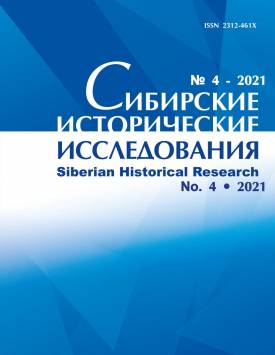Ethnocultural landscape of the Chukchi village of Meynypilgyno
The study of ethno-cultural landscapes is an actively developed research area at the interface of ethnology and human geography. Culture is an active socio-forming force which structures human habitat and opens in geographical landscape new contexts and meanings, which, in turn, actively influence culture. The article considers structure and evolution of ethno-cultural landscape formed in the course of development of the southern tundra coastallagoon ecosystem by the local community of the Meynypilgyno village on the Bering Sea coast. In 2016-2019, the author conducted informal and semi-formal interviews there, observed ritual practices and recorded folklore texts related to the natural landscape. Chukchi reindeer herders and sedentary Kerek fishermen were involved in the shaping of the landscape. Now they have merged into one local community and occupy a common ecological niche in the landscape. The used landscape area as well as the amount of used biological resources have greatly decreased during the last decades. The ethno-cultural sustainability of the community is maintained through the preservation of cultural codes. The most important of these are ritual practices, associated with folklore traditions. In symbolic form, they reflect people's relationship with both tundra and aquatic ecosystems. The preservation of the cultural codes maintains the balance in the landscape. It can also be linked to the restoration of the reindeer herding that was lost here 20 years ago. In this way, the mental components of the cultural landscape do not disappear, but, transforming themselves, continue to organize and guide the activities of the local community.
Keywords
cultural codes,
sacrifice,
ceremonies,
fishing,
reindeer husbandry,
traditional nature management,
Kereks,
Chukchies,
cultural landscapeAuthors
| Klokov Konstantin B. | Peter the Great Museum of Anthropology and Ethnography (Kunstkamera); Saint-Petersburg State University | k.b.klokov@gmail.com |
Всего: 1
References
Krupnik I., Mason R., Horton T. (eds.) Northern Ethnographic Landscapes: Perspectives from Circumpolar Nations. Wash.: Smithsonian National Museum of Natural History, 2004
Klokov K.B. Evolution of the Subsistence Pattern of Indigenous Population of the Coast of Southern Chukotka: Energy and Resources Aspects // IOP Conference Series: Earth and Environmental Science. Vol. 302: 4th International Scientific Conference Arctic: History and Modernity / Peter the Great St. Petersburg Polytechnic University, 2019. DOI: 10.1088/1755-1315/302/1/012077
Klokov K. Substitution and Continuity in Southern Chukotka Traditional Rituals: A Case Study from Meinypilgyno Village, 2016-2017 // Arctic anthropology. 2018. Vol. 55, № 2. P. 115-131
Ingold T. The Perception of the Environment: Essays on Livelihood, Dwelling and Dkill. London: Routledge, 2000
Ямсков А. Н. Этноэкологические исследования культуры и концепция культурного ландшафта // Культурный ландшафт: теоретические и региональные исследования: Сб. статей. М.: МГУ, 2003. С. 62-77
Толстой Н. И. Язык и народная культура: Очерки по славянской мифологии и этнолингвистике. М.: Индрик, 1995
Стрелецкий В. Н. Концепт культурного ландшафта в мировой культурной географии: научные истоки и современные интерпретации // Человек: образ и сущность. Гуманитарные аспекты. 2019. № 1 (36). C. 48-78
Сирина А. А. Чувствующие землю: экологическая этика эвенков и эвенов // Этнографическое обозрение. 2008. № 2. С. 121-138
Рагтываль Р. М. Мейныпильгынская коллекция семейных святынь. Краеведческие записки. Вып. 14. 1986. С. 170-191
Рагулина М.В. Культурная география: теории, методы, региональный синтез. Иркутск: Изд-во Института географии СО РАН, 2004
Нувано В.Н. Годовой хозяйственный цикл ваежских оленеводов в 1984-1986 гг.: ретроспективный взгляд // Прикладная этнология Чукотки: народные знания, музеи, культурное наследие. М.: PressPass, 2020. С. 35-57
Леонтьев В.В. Этнография и фольклор кереков. М.: Наука, 1983
Культурный ландшафт: теоретические и региональные исследования. М.: МГУ, 2003. Кытгаут-Тынетегина Е.И. Фольклор Беринговского района. СПб.: Лема, 2016. Лебедев В.В., Симченко Ю.Б. Ачайваамская весна. М.: Мысль, 1983
Кузнецова В.Г. Материалы по праздникам и обрядам амгуэмских оленных чукчей // Сибирский этнографический сборник. Т. 2. Труды Института этнографии им. Миклухо-Маклая. Новая серия. Т. XXXV. М.; Л.: Издательство АН СССР, 1957. С. 263326
Итоги переписи северных окраин Дальневосточного Края (1926-1927) с приложением карты северных окраин ДВК. Благовещенск: [б. и.], 1929
Калуцков В.Н. Ландшафт в культурной географии. М.: Новый хронограф, 2008
Гудков Д.Б., Ковшова М.Л. Телесный код русской культуры: материалы к словарю. М.: Гнозис, 2007
Богораз В.Г. Чукчи. Религия. Л.: Изд-во Главсевморпути, 1939. Ч. II
Гудков Д.Б. Единицы кодов культуры: проблемы семантики // Язык, сознание, коммуникация. М.: МАКС Пресс, 2004. Вып. 26. С. 39-50
Андреева Е.Д. Фольклор. Культурный ландшафт. Этнокультурная идентичность // Фольклор и этнокультурная идентичность. М.: РИИИ, 2014. С. 17-23

